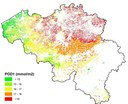Commissioned by MIRA and in collaboration with IRCEL, VITO constructed an ozone flux model. This model allows for the area-wide calculation of the Phytotoxic Ozone Dose (PODY) to be used as indicator for ozone damage to vegetation.
In the period 2007-2010, as commissioned by OVAM, VMM-MIRA and LNE, VITO and the Federal Planning Bureau developed the Flemish environmentally extended input-output model (EE-IO model). This model systematically links economic data to environmental and employment data, for the entire world economy.
How do megatrends influence the environment in Flanders?In the report 'Megatrends, far-reaching, but also out of reach? How do megatrends influence the environment in Flanders?' the Flanders Environment Report (MIRA) identifies six global megatrends, assuming that we cannot understand societal developments and their impact on the environment in Flanders without looking at such autonomous developments at the global level.
The Flemish government attempts to identify in good time all relevant contextual developments (horizon scanning). This enables us to accurately assess their impact on the environment(al policy). This study builds on the Megatrends report1 of the Flanders Environment Agency (VMM) and provides ways for the periodic monitoring of megatrends and other types of developments.
Economic welfare is traditionally measured using the gross domestic product (GDP). There are, however, also other factors to be taken into account, such as social and environmental aspects. The Index for Sustainable Economic Welfare (ISEW) offers an alternative approach. This MIRA report traces the evolution of the ISEW for Flanders over the period 1990-2013 using an improved methodology.
To what extent is climate change already visible in Flanders and Belgium? What are the expectations for the future? The answers to these questions can be found in the MIRA Climate Report 2015, which was compiled in collaboration with experts from the University of Leuven, the Flemish Institute for Technological Research (VITO) and the Royal Meteorological Institute (KMI).
Flanders is meeting many of the European air quality targets, for the first time also for particulate matter. Nonetheless, further efforts are needed for even better protection of public health. This can be read in the new report 'Air Quality in the Flemish Region in 2014'
Commissioned by MIRA, VITO developed a prototype or blueprint for a 'system dynamics model for Flanders'. A system dynamics model captures the dependencies between the state variables that drive the dynamic behaviour of a system. This allows to calculate different combinations of scenarios and policy choices in a consistent manner, and to determine the medium- and long-term impact to be determined.
Day after day, we are working together with you on tomorrow's environment. Our new look presentation brochure includes some useful tools that will help you nicely along your way.
Societal systems are more and more reaching their limits: we face the important challenge of meeting both our present and future needs within the capacity of our planet. In the new MIRA publication "System Balance 2017", we examine to what extent the energy, mobility and food systems in Flanders are in environmental balance and what system changes are needed.
From 18 July onwards Flanders Environment Agency (VMM) will investigate the salinization of the groundwater in coastal- and polder areas in Flanders. The investigation will be taken airborne, as all the information required will be collected during helicopter flights.
Have you ever heard about Project ZULU (Zuivere Lucht)? The aim of Project ZULU is to limit the impact of pollutants on the indoor air quality. Innovative purification technologies are being optimised and tested for implementation to benefit sensitive groups. In collaboration with the inhabitants, we measure the air quality and conceive targeted local solutions.
The MIRA Environmental Outlook 2018 presents an in-depth analysis of the energy, mobility and food systems.
Internet of Water Flanders is a research and innovation project to develop and deploy a system to digitally monitor, in real-time, water quality indicators across Flanders.
On Friday 4 June, the digital closing event of the LIFE VAQUUMS project took place. 80 interested parties gathered to find out about the results and the findings of the project. There were many interesting questions and enthusiastic reactions from the participants.
The VMM intends to adopt an even stronger position as a solution-oriented partner. In this way, we want to have a positive impact on the Flemish living environment and help make it climate resilient.
The international project 'Clancy' is intended to find suitable strategies for combating the countless Chinese mitten crabs in Northern European river systems.
On March 12, the European Water Conference took place in Leuven, under the title "Speeding up to a water resilient Europe". Over 200 policy makers and water sector experts from across Europe participated in this event, organized by the Flemish Environment Agency (VMM) as part of the Belgian EU Presidency. The conference offered valuable perspectives and insights on water resilience in Europe.












